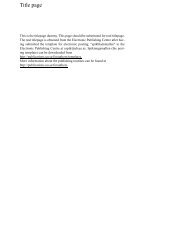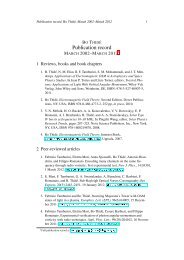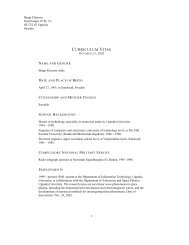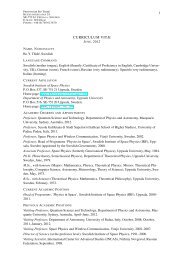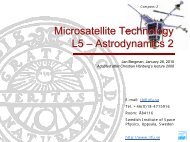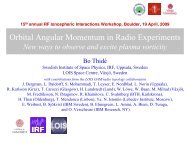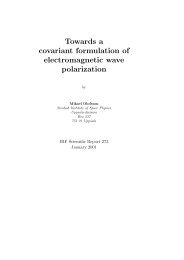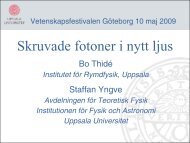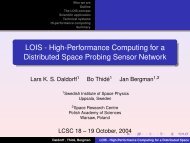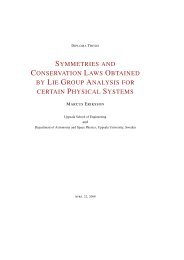Atmosphere-Ionosphere Mission - Swedish Institute of Space ...
Atmosphere-Ionosphere Mission - Swedish Institute of Space ...
Atmosphere-Ionosphere Mission - Swedish Institute of Space ...
You also want an ePaper? Increase the reach of your titles
YUMPU automatically turns print PDFs into web optimized ePapers that Google loves.
<strong>Atmosphere</strong>-<strong>Ionosphere</strong> <strong>Mission</strong><br />
Response to the <strong>Swedish</strong> National <strong>Space</strong> Board “Call for Ideas”<br />
Elaborate Science Case<br />
Edited by Bo Thidé, IRF, Uppsala<br />
September, 2002<br />
Abstract<br />
As a response to the <strong>Swedish</strong> National <strong>Space</strong> Board (SNSB) “Call for<br />
Ideas” for new <strong>Swedish</strong> national space missions, we proposed the establishment<br />
<strong>of</strong> a mission consisting <strong>of</strong> a series <strong>of</strong> low-altitude <strong>Swedish</strong> satellites for<br />
studying, in the broadest sense, radiation phenomena in the upper atmosphere<br />
and ionosphere. Such a mission would be truly cross-disciplinary in nature<br />
and <strong>of</strong> high interest to many parties in Sweden and in the international space<br />
community. It would have a strong bearing on fundamental questions regarding<br />
atmospheric and ionospheric physics (in particular transition layer wave<br />
and turbulence dynamics), solar impact on the upper atmosphere, near-Earth<br />
space environmental physics (notably anthropogenic effects due to radiation<br />
from VLF to laser frequencies), and satellite and telecom technology development.<br />
Thereby it would constitute an excellent platform for innovative<br />
research and development <strong>of</strong> new technology <strong>of</strong> high national and international<br />
interest and importance.<br />
On demand from the SNSB, we present here a more elaborate science<br />
case for the AIM spacecraft project.<br />
1 Summary<br />
The upper atmosphere and the ionosphere is a boundary region between Earth and<br />
space which is subject to numerous interactions between the gas-plasma mixture<br />
and electromagnetic (EM) radiation. While the plasma in this region is generated<br />
mainly by the extremely high-frequency EM radiation (UV, X-ray) <strong>of</strong> solar origin,<br />
the relatively much lower frequency EM radiation <strong>of</strong> natural and anthropogenic<br />
origin, emanating from sources in the lower atmosphere (e.g., thunderstorms) and<br />
on the ground (e.g., radio transmitters), gives rise to plasma turbulence which, in<br />
turn, may generate EM radiation. The various kinds <strong>of</strong> radiation contribute to the<br />
overall, and ever increasing, “electrosmog.”<br />
The proposed <strong>Atmosphere</strong>-<strong>Ionosphere</strong> <strong>Mission</strong> (AIM) will be designed to investigate<br />
the still largely unknown mechanisms which govern these turbulent interactions.<br />
The experimental methodology, combining the remote and in situ measurements<br />
from the AIM satellites and ground-based observations, will focus on the<br />
following four studies:<br />
1
SUMMARY 2<br />
1. Studies <strong>of</strong> the effects <strong>of</strong> controlled radio wave injections from purpose-built<br />
radio research facilities at various locations (Arecibo, Puerto Rico; HAARP,<br />
Gakona, Alaska; HIPAS, Chena Hot Springs, Alaska; EISCAT, Tromsø,<br />
Norway; SPEAR, Svalbard; Sura, Nizhniy Novgorod, Russia; LOIS, southern<br />
Sweden). Through laboratory-type experiments, a systematic mapping<br />
out <strong>of</strong> the fundamental underlying physical processes will be tried. The<br />
studies will include coupling mechanisms between the artificially perturbed<br />
lower ionosphere and the magnetosphere as well as the upper atmosphere.<br />
Particular attention will be paid to the role played by Alfvén waves in these<br />
processes.<br />
2. Studies <strong>of</strong> radiation-turbulence interactions above geographical regions with<br />
a high density <strong>of</strong> very powerful broadcast and TV stations (e.g., central<br />
Europe and the Far East). Comparisons with results obtained in step 1 are<br />
expected to reveal what impact man-made radio and TV transmissions have<br />
on the Earth’s space environment.<br />
3. Studies <strong>of</strong> EM radiation and interaction effects associated with thunderstorms,<br />
known to be frequent and to emit high powers <strong>of</strong> EM radiation and<br />
poorly understood associated phenomena such as sprites. The influence <strong>of</strong><br />
these natural perturbations will be compared with the man-made perturbations<br />
described in steps 1 and 2 to assess their relative importance and impact.<br />
These studies are probably best performed over the tropics.<br />
4. Studies <strong>of</strong> the Earth’s EM environment over pristine areas (e.g. the Pacific<br />
Ocean) where very few radio and TV stations are operated and thunderstorms<br />
are relatively rare. These measurements will be used as a reference against<br />
which the other measurements will be benchmarked.<br />
The <strong>Atmosphere</strong>-<strong>Ionosphere</strong> <strong>Mission</strong> is envisioned as a first in a series <strong>of</strong><br />
micro-satellites oriented toward ionosphere and upper atmosphere research with<br />
the objective to widen our knowledge <strong>of</strong> the intricate turbulent processes in this<br />
boundary region and, in the process, widen the space applications in Sweden by<br />
gradually including institutions which have not participated in space activities so<br />
far. These inexpensive platforms would serve also as testing facilities for new<br />
miniaturised devices and technologies.<br />
The proposed AIM project will consist <strong>of</strong> two satellites <strong>of</strong> the Astrid type in an<br />
elliptical orbit with a perigee <strong>of</strong> about 250–300 km and about 70 ◦ inclination. The<br />
apogee should be determined in such a way that the longevity <strong>of</strong> the mission is 6<br />
months or more. A mission with two satellites is important for scientific reasons,<br />
as it would make possible to resolve some problems related to spatio-temporal ambiguity<br />
discussed below. It would be also interesting and challenging for <strong>Swedish</strong><br />
space industry, which has a sufficient experience with deployment and management<br />
<strong>of</strong> single satellites.<br />
<strong>Atmosphere</strong>-<strong>Ionosphere</strong> <strong>Mission</strong><br />
Elaborate Science Case
AIM SCIENCE 3<br />
AIM will supplement a number <strong>of</strong> previous space missions. Several successful<br />
<strong>Swedish</strong> satellite missions (Viking, Freja, Astrid 1–2) have explored mainly auroral<br />
phenomena in the magnetosphere in the altitude range 1000–13500 km. The<br />
Cluster II spacecraft measure even further out in the magnetosphere. AIM with its<br />
significantly lower orbit will investigate a different region <strong>of</strong> the near-Earth space<br />
environment. The recent Odin satellite at 622 km (higher altitude than AIM) is focused<br />
on astrophysics and atmospheric sciences. Whereas Odin is a dual discipline<br />
mission, AIM with its explicit cross-disciplinary focus seeks to engage new users<br />
<strong>of</strong> space experiments and thereby to catalyse new fields <strong>of</strong> research collaborations<br />
in the <strong>Swedish</strong> physics community.<br />
AIM will also supplement the CORONAS-1 measurements <strong>of</strong> the radio noise<br />
in the lower HF band.<br />
Furthermore, AIM with its focus on electromagnetic phenomena would supplement<br />
the SAMPEX (Solar, Anomalous, and Magnetospheric Particle Explorer)<br />
mission. SAMPEX with its near polar orbit (520–670 km) was devoted entirely to<br />
the detection <strong>of</strong> energetic electrons and ion composition. Particularly, the mission<br />
surveyed relativistic electrons and measured its impact on the upper atmosphere.<br />
The energetic electrons would come from solar flares, supernova explosions, or<br />
be precipitated radiation belt electrons due to lightning in thunderstorms. Thus,<br />
widely different regions <strong>of</strong> space are coupled by accelerated electrons. One <strong>of</strong> the<br />
tasks <strong>of</strong> AIM would be to similarly study coupling between the atmosphere, ionosphere,<br />
magnetosphere, interplanetary and interstellar space, but from the point <strong>of</strong><br />
view <strong>of</strong> electromagnetics. For example, precipitating energetic electrons, whether<br />
from the radiation belts, solar flares, or further out in space, produce electromagnetic<br />
radiation when interacting with the dense atmosphere. Detection <strong>of</strong> this radiation<br />
allows monitoring <strong>of</strong> the energetic interactions from some distance without<br />
the spacecraft actually having to be exactly in the same region as the energetic<br />
electrons, which is also expected to give more data. It is now understood that thunderstorms<br />
in the troposphere are strongly coupled to the overlaying atmosphere,<br />
ionosphere, and magnetosphere. The influence <strong>of</strong> lightning driven electrodynamic<br />
processes on the global upper atmosphere and near-Earth space environment is<br />
emphasised by the fact that up to about 2000 thunderstorms are active at any time<br />
around the Earth, with about 40000 lightning discharges occurring every second.<br />
2 AIM Science<br />
Several successful <strong>Swedish</strong> missions have explored auroral phenomena in the magnetosphere<br />
at the altitude range 1000–6000 km (Freja, Viking, Astrid 1/2) and the<br />
recent Odin satellite contributes to astrophysics and atmospheric sciences. Furthermore,<br />
a number <strong>of</strong> satellites have explored distant magnetospheric regions, the<br />
most prominent example being the ongoing Cluster project [11], and several missions<br />
aimed at the investigation <strong>of</strong> other planets, asteroids and comets are now<br />
being implemented by NASA, ESA and the Japanese <strong>Space</strong> Agency.<br />
However, the international space science community is presently witnessing<br />
<strong>Atmosphere</strong>-<strong>Ionosphere</strong> <strong>Mission</strong><br />
Elaborate Science Case
AIM SCIENCE 4<br />
vibrant multi-disciplinary research and a rapidly expanding frontier concerning the<br />
interaction <strong>of</strong> the upper atmosphere and ionosphere. This research concerns fields<br />
such as atmospheric electricity and electrodynamics (including that <strong>of</strong> thunderstorm<br />
centres), space weather, influence <strong>of</strong> solar activity on climate, to mention a<br />
few. In view <strong>of</strong> this important activity and, on the other hand, the decades long<br />
trend <strong>of</strong> missions further and further out in space, we would like to see a mission<br />
back to the Earth with a fresh, innovative perspective which also comprises<br />
environmental and technology aspects.<br />
The atmospheric-ionospheric regions below typical space shuttle altitudes (350–<br />
400 km) are very poorly explored by measurements in situ because <strong>of</strong> atmospheric<br />
drag which shortens satellite lifetimes. This region is <strong>of</strong> major scientific importance<br />
because it is a transition region between the neutral atmosphere and the completely<br />
ionised magnetosphere, with strong ionisation gradients, electric jets, complicated<br />
chemistry, turbulence, dusty plasma and complex physical phenomena. The processes<br />
in this transition region connect the solar and magnetospheric effects with<br />
the atmospheric response which, in fact, determine space weather in the Earth’s<br />
environment. This region is also the part <strong>of</strong> the Earth’s atmosphere where electromagnetic<br />
radiation from natural sources such as lightnings, and artificial sources<br />
such as radio, TV and radar transmitters, exhibit resonance and other interaction<br />
phenomena. The impact <strong>of</strong> these natural and man-made effects on the Earth’s space<br />
environment are <strong>of</strong> major public concern. Hence, studies <strong>of</strong> such effects are called<br />
for. On the other hand, the ionosphere is a region <strong>of</strong> closure <strong>of</strong> magnetospheric current<br />
systems and a reflection layer for Alfvén wave resonators. Consequently, the<br />
proposed mission is <strong>of</strong> considerable interest also for the solar wind-magnetosphereionosphere<br />
coupling.<br />
The AIM satellites are to be designed for correlated studies <strong>of</strong> phenomena associated<br />
with electromagnetic radiation, <strong>of</strong> natural as well as anthropogenic origin,<br />
in the ELF to HF (DC–30 MHz) and microwave ranges as well as UV, X-ray, and<br />
gamma radiation. We suggest a first constellation <strong>of</strong> two satellites in the same low<br />
altitude elliptical orbit in order to help resolve the spatio-temporal ambiguity <strong>of</strong><br />
space measurements as illustrated in Figure 1.<br />
The high-frequency receiver on Freja satellites operated only up to 4 MHz with<br />
short snapshots <strong>of</strong> 0.5 ms. Still, it provided a wealth <strong>of</strong> new information on parametric<br />
interactions between Langmuir and lower hybrid waves. An example <strong>of</strong> a<br />
time-series recorded by this instrument is shown in Figure 2 . The AIM instrumentation<br />
will provide a considerably more comprehensive data base with time-series<br />
data which will be used for advanced study <strong>of</strong> wave processes in the topside ionosphere.<br />
2.1 Man-made radio wave effects on the atmosphere-ionosphere<br />
In situ measurements <strong>of</strong> the turbulence driven by a powerful radio wave in the ionosphere<br />
has been recognised as the single-most important experiment to advance our<br />
understanding <strong>of</strong> the response <strong>of</strong> the ionospheric plasma during electromagnetic ir-<br />
<strong>Atmosphere</strong>-<strong>Ionosphere</strong> <strong>Mission</strong><br />
Elaborate Science Case
AIM SCIENCE 5<br />
1000 km<br />
<strong>Ionosphere</strong><br />
Self−organised<br />
plasma ducts<br />
Satellite<br />
High−frequency wave<br />
Turbulent<br />
plasma<br />
volume<br />
Low−frequency wave<br />
Satellite<br />
100 km<br />
10 km<br />
<strong>Atmosphere</strong><br />
Geo−<br />
magnetic<br />
field<br />
Secondary<br />
electromagnetic<br />
radiation<br />
Primary<br />
electromagnetic<br />
wave<br />
FIGURE 1: Sketch <strong>of</strong> an in situ experiment measuring the response <strong>of</strong> the<br />
ionospheric plasma to the irradiation <strong>of</strong> an electromagnetic wave field from a<br />
powerful ground-based radio transmitter.<br />
radiation [16, 20]. In addition to being important to fundamental plasma physics<br />
such measurements are instrumental to understand the effects <strong>of</strong> anthropogenic<br />
activity, due to, for example, radio broadcast transmitters, on the near-Earth space<br />
environment.<br />
The controlled injection <strong>of</strong> powerful HF radio waves from purpose-built groundbased<br />
radio facilities into the ionospheric plasma has constituted an excellent tool<br />
to study systematically the near-Earth space environment and its responses to external<br />
and internal influences as well as the physical principles that underpin the<br />
processes in question.<br />
Controlled experiments using purpose-built radio transmitters have shown that<br />
non-linear interactions in the ionosphere give rise to noise-like secondary EM radiation<br />
[29]. This radiation is particularly strongly excited when the frequency <strong>of</strong><br />
the injected radio wave is near a harmonic <strong>of</strong> the ionospheric electron cyclotron<br />
frequency [3]; see Figure 3. Similar sideband structures are expected when radio<br />
waves from powerful broadcast stations propagate in the ionosphere. Critical elements<br />
<strong>of</strong> the theory are still missing. Only measurements from AIM or similar<br />
spacecraft can provide the necessary experimental input which makes it possible to<br />
understand the complicated non-linear ionospheric plasma processes responsible<br />
for the sideband emissions.<br />
By the use <strong>of</strong> the Tromsø HF heating facility it is proposed to perform experimental<br />
measurements both in situ from the AIM satellites inside <strong>of</strong> the heaterinduced<br />
patch and from supporting ground-based measurements including SEE<br />
techniques, and multi-static coherent HF scatter studies, EISCAT UHF incoherent<br />
<strong>Atmosphere</strong>-<strong>Ionosphere</strong> <strong>Mission</strong><br />
Elaborate Science Case
AIM SCIENCE 6<br />
FIGURE 2: Examples <strong>of</strong> dynamic waveform data captured by the Freja HF<br />
receiver. We can expect this and more for the AIM satellites. The AIM<br />
digital receivers are designed to much better cope with such data than the<br />
Freja receivers.<br />
<strong>Atmosphere</strong>-<strong>Ionosphere</strong> <strong>Mission</strong><br />
Elaborate Science Case
AIM SCIENCE 7<br />
FIGURE 3: Examples <strong>of</strong> noise-like Stimulated Electromagnetic Emission<br />
(SEE) sidebands around an HF signal, transmitted from the ground, at frequencies<br />
below, at and above the fourth electron gyro frequency in the ionosphere.<br />
These results from experiments 1998 at the Sura facility, Russia [3],<br />
where the primary radio wave frequency was swept across the fourth gyro<br />
harmonic, clearly show the extreme sensitivity <strong>of</strong> the excitation <strong>of</strong> the sidebands<br />
(and the ensuing loss <strong>of</strong> energy in the primary radio signal) on this<br />
frequency relation.<br />
scatter radar studies, optical measurements and the IMAGE magnetometer network<br />
in Scandinavia.<br />
One hypothesis that will be tested is that the anomalous tunnelling <strong>of</strong> radio<br />
waves that was observed in earlier satellite experiments [19] is caused by the<br />
coupling to Langmuir waves. In radar experiments such Langmuir waves have<br />
been observed at the ionospheric topside during HF interactions at the bottomside<br />
[14, 17, 18]. With AIM measurements in situ we want to test the hypothesis that<br />
the unexpected observations are due to kinetic tunnelling in which the electrons in<br />
the inhomogeneous ionospheric plasma are trapped inside the self-consistent potential<br />
and keep their phase memory until they reach the far side <strong>of</strong> the potential<br />
and there arrive in phase again causing the recurrence <strong>of</strong> the Langmuir wave as illustrated<br />
in Figure 4 which was obtained by solving the Vlasov-Maxwell equations<br />
numerically [9, 10].<br />
The planned highly sensitive LOIS-LOFAR space radar in northwestern continental<br />
Europe and southern Scandinavia [28] will be a very fruitful tool for such<br />
studies in the future; see Figure 5. LOIS-LOFAR will provide information about<br />
the physical processes going on along magnetic field lines footprinted on Tromsø<br />
at different altitudes. A 3-D view <strong>of</strong> the experiment geometry by the use <strong>of</strong> multiinstrument<br />
ground-based observations combined with in-situ AIM satellite measurements<br />
is shown in Figure 6. A similar experiment strategy can be used also at<br />
the HAARP and HIPAS facilities.<br />
<strong>Atmosphere</strong>-<strong>Ionosphere</strong> <strong>Mission</strong><br />
Elaborate Science Case
¦<br />
¡<br />
¡<br />
¢<br />
£<br />
¤<br />
¤<br />
£<br />
¢<br />
¡<br />
¡<br />
¢<br />
£<br />
¤<br />
AIM SCIENCE 8<br />
¥ §¨§©<br />
<br />
¤<br />
<br />
£<br />
<br />
¡¦¦¦<br />
¢<br />
¥<br />
<br />
<br />
¦<br />
¥<br />
¨<br />
¡¦¦¦<br />
¥¦¦ ¦ ¥¦¦ ¡¦¦¦ ¥¦¦ ¦ ¥¦¦<br />
FIGURE 4: Phase space plots <strong>of</strong> the Langmuir wave at four different time<br />
steps after the appearance <strong>of</strong> the wave at the bottomside ionosphere (lefthand<br />
part <strong>of</strong> phase space). The reappearance <strong>of</strong> the Langmuir wave is clearly<br />
seen at the topside ionosphere (right-hand part <strong>of</strong> phase space) after 2500<br />
plasma periods (panel d).<br />
<strong>Atmosphere</strong>-<strong>Ionosphere</strong> <strong>Mission</strong><br />
Elaborate Science Case
AIM SCIENCE 9<br />
LOFAR and LOIS sites<br />
Tromsø<br />
Kiruna<br />
O<br />
57 N<br />
Onsala<br />
København<br />
Uppsala<br />
Linköping<br />
Växjö<br />
Lund<br />
Dwingeloo<br />
FIGURE 5: Proposed LOFAR and LOIS sites.<br />
<strong>Atmosphere</strong>-<strong>Ionosphere</strong> <strong>Mission</strong><br />
Elaborate Science Case
AIM SCIENCE 10<br />
FIGURE 6: The geometry <strong>of</strong> EISCAT/Heating/AIM experiments supported<br />
by ground-based instruments such as the bistatic HF scatter passive radar<br />
London–Tromsø–St. Petersburg and the planned LOIS deep space radar facility<br />
in southern Scandinavia.<br />
It has been observed in the equatorial ionosphere (EXOS-C), as well as in the<br />
polar ionosphere (ARCAD-3, ISIS-2, Freja, FAST) that HF emission enhancements<br />
can manifest themselves in terms <strong>of</strong> narrow bands located close to the frequency<br />
<strong>of</strong> the resonance cone and broad bands but is not always correlated to<br />
the upper-hybrid frequency band. On the other hand, enhancement at the upperhybrid<br />
range in the polar ionosphere was permanently detected on board ARIEL-3,<br />
ARIEL-4 and EXOS-C. In spite <strong>of</strong> many theoretical models <strong>of</strong> the mechanism <strong>of</strong><br />
generation <strong>of</strong> upper-hybrid emissions such as (i) incoherent Vavilov-Čerenkov radiation;<br />
(ii) amplification <strong>of</strong> incoherent emission by various convective plasma instabilities;<br />
(iii) generation <strong>of</strong> noise in the antenna by thermal plasma fluctuation, it<br />
is still unclear which geophysical conditions favour the excitation <strong>of</strong> upper-hybrid<br />
emissions.<br />
The spectra measured in the HF frequency range onboard the Intercosmos-19,<br />
Cosmos-1809, ACTIVE, APEX and CORONAS-I satellites revealed unusual features<br />
suggesting a strong modification <strong>of</strong> the electron plasma in the topside ionosphere<br />
over densely populated areas <strong>of</strong> Europe and Asia. The location <strong>of</strong> broadband<br />
enhancements <strong>of</strong> about 20 dB relative to the cosmic noise over these areas<br />
is evident. It is worth mentioning that the geographical coverage <strong>of</strong> emission patterns<br />
below the ionospheric critical frequency f 0F2 does not follow exactly the geographical<br />
coverage <strong>of</strong> those in the frequency higher than f 0F2 . The local time <strong>of</strong> the<br />
coverage <strong>of</strong> the broadband enhancement <strong>of</strong> this emission extends from the evening<br />
<strong>Atmosphere</strong>-<strong>Ionosphere</strong> <strong>Mission</strong><br />
Elaborate Science Case
AIM SCIENCE 11<br />
to the morning hours and its intensity depends on the geomagnetic activity. There<br />
exists a certain threshold <strong>of</strong> the radiation impinging on the ionosphere to excite<br />
the plasma response. In this context correlated ground-based heating and overhead<br />
satellite measurements are still needed for better understanding <strong>of</strong> these processes.<br />
The HF emission from permanently operating ground-based broadcasting transmitters<br />
traversing the ionosphere and its large scale structures observed in the<br />
topside ionosphere display all ionospheric global patterns. This picture contains<br />
also HF radiation components from thunderstorms. The recognition <strong>of</strong> these patterns,<br />
as well as an elaboration <strong>of</strong> the tools for extracting selective information on<br />
their dynamics can be used for monitoring the electromagnetic ecosystem for space<br />
weather purposes.<br />
2.1.1 Ionospheric-magnetospheric coupling<br />
Recently it has been discovered that man-made perturbations from the ground by<br />
radio waves can have an impact on the ionosphere-magnetosphere coupling in the<br />
form <strong>of</strong> artificial triggering <strong>of</strong> auroral activations, plasma instabilities, electromagnetic<br />
emissions and other non-linear phenomena [1, 2]. It is <strong>of</strong> high importance<br />
to obtain further evidences for the modification <strong>of</strong> the electromagnetic ionospheremagnetosphere<br />
coupling due to effects <strong>of</strong> radio waves from the ground on the highlatitude<br />
ionosphere, including the role <strong>of</strong> the plasma instabilities and non-linear<br />
phenomena in the artificial triggering <strong>of</strong> auroral activations. Which non-linear<br />
plasma physical mechanisms are responsible for this anthropogenic effect is still<br />
an open question. Correlated and detailed in situ measurements <strong>of</strong> this ionospheric<br />
turbulence from AIM-like satellites are the only means to settle this question.<br />
Taking into account the distinctive behaviour and features <strong>of</strong> the night-side auroral<br />
ionosphere such as the ionospheric convection, field-aligned currents, intense<br />
electrojets and precipitating particles, one can expect that the propagation <strong>of</strong> highpower<br />
radio waves in this medium can lead to the excitation <strong>of</strong> modification effects<br />
not encountered in the day-side undisturbed ionosphere. It was discovered by<br />
Blagoveshchenskaya et al. [1] that the injection <strong>of</strong> HF radio waves into the nightside<br />
auroral ionosphere leads to the modification <strong>of</strong> the ionosphere-magnetosphere<br />
coupling that, in turn, may cause the triggering <strong>of</strong> local auroral activations in the<br />
magnetic flux tube footprinted on the HF heating facility located at auroral latitudes.<br />
In this respect further studies <strong>of</strong> the physical processes and phenomena, and<br />
possible mechanisms for the modification <strong>of</strong> the ionosphere-magnetosphere coupling<br />
due to the impact <strong>of</strong> powerful HF radio waves on the auroral ionosphere are<br />
called for.<br />
2.1.2 Ionospheric and magnetospheric Alfvén resonators<br />
In various theories <strong>of</strong> ionosphere-magnetosphere interactions, the existence <strong>of</strong> two<br />
resonators is postulated: one that confines Alfvén waves bouncing between the<br />
ionosphere and the low density region at 1R e (auroral acceleration region), which<br />
should produce circa 1 Hz oscillations in the electromagnetic fields and particles<br />
<strong>Atmosphere</strong>-<strong>Ionosphere</strong> <strong>Mission</strong><br />
Elaborate Science Case
AIM SCIENCE 12<br />
[27, 30]. The other is a global oscillator which corresponds to Alfvén waves<br />
bouncing between northern and southern hemispheres, which correspond to a few<br />
minutes oscillation period [27]. Two AIM satellites flying on the same orbit with a<br />
1 minute separation time (TBD) would be able to investigate incoming and reflected<br />
waves, and in this way contribute to resolve this important but still controversial<br />
problem.<br />
It is essential that the frequency range be extended down to the near-DC level<br />
in order to investigate several phenomena, which have not been resolved by previous<br />
missions, but are <strong>of</strong> considerable interest for the <strong>Swedish</strong> and international<br />
space physics community. Thus, measurements <strong>of</strong> electric and magnetic fields in<br />
the frequency range 0-1 kHz (which covers Alfvén, ion cyclotron and ion plasma<br />
modes) could provide answer for the following outstanding problems:<br />
2.1.3 Small-scale currents, dispersive Alfvén waves<br />
Previous <strong>Swedish</strong> missions (Freja, Astrid-2), have revealed extremely strong currents<br />
<strong>of</strong> 500 µA/m 2 on spatial scales <strong>of</strong> 200 m, which corresponds to electron skin<br />
depth at ionospheric altitudes. Normal field-aligned currents in auroral zone are<br />
hundred times smaller. These small-scale, intense current structures are associated<br />
with strong electron heating and production <strong>of</strong> higher frequency Langmuir and<br />
whistler waves. The current structures are postulated to be related to dispersive<br />
Alfvén waves, i.e., Alfvén waves that propagate oblique to the magnetic field and<br />
produce short-scale striations in the direction perpendicular to the magnetic field.<br />
There is a number <strong>of</strong> questions related to these structures: (i) at which altitude<br />
are they produced? (ii) what is the role <strong>of</strong> ionospheric reflections in producing<br />
the structures? What is life-time and stability <strong>of</strong> these currents? These important<br />
questions could be answered by instruments on two proposed AIM satellites.<br />
2.1.4 Mechanisms for outflow <strong>of</strong> ionospheric ions<br />
What is the initial mechanism that pre-heats the ionospheric ions (mainly oxygen)<br />
which then are ejected upward by the mirror force and parallel electric fields,<br />
is a widely debated problem. The postulated mechanisms include lower hybrid<br />
waves, ion-cyclotron waves, and dispersive Alfvén waves via a stochastic acceleration<br />
[13, 23]. Since the proposed wave instrumentation cover all the possible ion<br />
plasma frequencies, we should be able to determine the dominant transverse heating<br />
mechanism that operates at the topside ionosphere. For this purpose a Langmuir<br />
probe operating in the ion current mode would be appropriate complement <strong>of</strong><br />
the AIM instrumentation. Experiments show that ion outflows can be caused by<br />
radio waves from powerful radio transmitters.<br />
2.2 Natural thunderstorm effects on the atmosphere-ionosphere<br />
Following some lightning flashes from energetic thunder-clouds, blue jets and red<br />
sprites (see Figure 7) are observed in the atmosphere above the clouds and into<br />
<strong>Atmosphere</strong>-<strong>Ionosphere</strong> <strong>Mission</strong><br />
Elaborate Science Case
AIM SCIENCE 13<br />
FIGURE 7: Lightning-induced red sprites.<br />
the ionosphere [25, 26]. This phenomenon clearly demonstrates that the EM fields<br />
generated by thunder-clouds and lightning couple strongly with the upper atmosphere<br />
and the ionosphere. Measurement <strong>of</strong> EM radiation up to frequencies <strong>of</strong><br />
10 MHz from low altitude satellite would be able to quantify the magnitude <strong>of</strong> the<br />
electric fields produced by thunderstorms at those altitudes and compare the results<br />
with theoretical predictions. Moreover, the data could be correlated with the<br />
weather information and radar observations from ground based stations to observe<br />
the enhancement <strong>of</strong> the EM fields due to thunderstorms and lightning flashes with<br />
an aim to quantify the heating <strong>of</strong> the ionospheric electrons due to terrestrial thunderstorms.<br />
The data could also be combined with the information on lightning<br />
strikes coming out from the <strong>Swedish</strong> and US lightning direction finding systems to<br />
correlate the individual enhancements in the EM fields observed at high altitudes<br />
with the individual lightning flashes.<br />
Balloon-borne gamma-ray and electric field meters launched into thunderstorms<br />
detected a three-fold increase in the gamma ray flux as the balloon ascended through<br />
the anvil <strong>of</strong> the thunder-cloud [4, 5]. The theory suggests that the gamma ray bursts<br />
are produced by the acceleration <strong>of</strong> cosmic ray produced seed electrons in thunderstorm<br />
electric fields. This theory calls for a simultaneous measurements <strong>of</strong> the<br />
EM fields and the gamma ray counts and correlation with the presence <strong>of</strong> lightning<br />
activity.<br />
<strong>Atmosphere</strong>-<strong>Ionosphere</strong> <strong>Mission</strong><br />
Elaborate Science Case
TECHNOLOGY 14<br />
The first positive band <strong>of</strong> N 2 is the dominant optical emission <strong>of</strong> sprites that<br />
occur in the altitude range around 70 km. An optical recorder that could detect this<br />
band would be able to record the occurrence <strong>of</strong> sprites in space and time around<br />
the globe. This information could be coupled with the ground based lightning<br />
detection systems to evaluate, not only the number <strong>of</strong> sprites that are created in the<br />
upper atmosphere per second, but also the conditions under which these lightning<br />
flashes are created.<br />
2.3 Modelling<br />
Satellite-based mobile multimedia networks are expected to play a significant role<br />
in next generation mobile communication systems and an integral and essential<br />
part <strong>of</strong> the global multimedia infrastructure. This is because they can provide<br />
cost effective access to the global multimedia infrastructure in areas where their<br />
terrestrial counterparts require high cost and, in general, inefficient utilisation. Deploying<br />
satellite mobile multimedia networks in these areas and integrating them<br />
with the terrestrial mobile infrastructure, mobile multimedia services could be<br />
<strong>of</strong>fered seamlessly worldwide. For the above reason, it is important to investigate<br />
the performance <strong>of</strong> these systems and to engineer appropriate solutions capable <strong>of</strong><br />
providing multimedia services characterized by high transmission rates and better<br />
quality <strong>of</strong> services (QoS). In this context, a number <strong>of</strong> different satellite configurations<br />
will be considered.<br />
The AIM satellites will, together with the planned LOIS infrastructure, provide<br />
a ground-space infrastructure which can be used to model and test ideas for new<br />
methods <strong>of</strong> satellite communications, in particular multiple-input, multiple-output<br />
(MIMO) techniques [22].<br />
The Department <strong>of</strong> Scientific Computing at Uppsala University has a well established<br />
high competence in using and developing numerical methods for the solution<br />
<strong>of</strong> partial differential equations typical for the type <strong>of</strong> physical problems to be<br />
studied in the AIM mission such as flow problems, electromagnetic radiation and<br />
wave propagation [6, 7, 8, 9, 10, 12, 21]. A new parallel computer with 48 processors<br />
has recently been installed and a PC cluster is available at the department.<br />
These computing resources will be used to model both the turbulence and radiation<br />
physics and the electromagnetic properties <strong>of</strong> the AIM platform and antennas. In<br />
an ongoing project in cooperation with the <strong>Institute</strong> <strong>of</strong> <strong>Space</strong> Physics, the nonlinear<br />
interactions between particles and electromagnetic radiation in a magnetised<br />
plasma are modelled by the Maxwell-Vlasov equations. The equations are solved<br />
accurately in large scale simulations on these machines.<br />
3 Technology<br />
The mission with its requirements for smart and small payloads and spacecraft is<br />
important for advanced technology development and <strong>of</strong> express interest to industry.<br />
The same can be said about the low orbit and high data transfer rates required. The<br />
<strong>Atmosphere</strong>-<strong>Ionosphere</strong> <strong>Mission</strong><br />
Elaborate Science Case
TECHNOLOGY 15<br />
low orbit gives an opportunity for technological developments to reduce the aeronomic<br />
drag on the spacecraft. The experimental data on the ionospheric plasma<br />
physical conditions that the AIM mission will provide, will make it possible for<br />
the scientists to better describe the non-linear aspects <strong>of</strong> the interaction between<br />
radio signals and the ionospheric plasma and thus, as a spin-<strong>of</strong>f, provide the telecommunication<br />
industry with more accurate models and tools for making optimum<br />
use <strong>of</strong> space for telecom purposes (‘satellite phones’, ‘Internet in the sky’ etc). It<br />
has namely been realised that the link budget analyses made for these applications<br />
have not included a correct model <strong>of</strong> the propagation medium (the plasma) simply<br />
because the knowledge about this medium was not good enough. As recent experiments<br />
have shown, the interaction between several strong radio waves, separated<br />
by frequencies that are resonant in the plasma, will give rise to turbulence, phase<br />
distorting irregularities, a population <strong>of</strong> high-energetic electrons, signal damping<br />
and noise.<br />
Further, by providing simple telemetry receiving systems for educational institutions<br />
a public outreach <strong>of</strong> unprecedented impact would be gained, which comes<br />
in addition to that <strong>of</strong> the obvious scientific environmental issues being addressed<br />
and the advanced technological requirements by the mission.<br />
IRF in Uppsala have nearly twenty years <strong>of</strong> experience in developing advanced<br />
digital HF radio systems for scientific use and have, during the past several years,<br />
developed similar systems for satellites within the SNSB-funded project “Nanosatellite<br />
Technology.” The design, construction and prototyping <strong>of</strong> the digital receivers<br />
is now finished. In addition to the IRF HF radio systems, the payload will<br />
contain other EM radiation sensors, include DC electric and magnetic field sensors<br />
and a Langmuir probe.<br />
The Department <strong>of</strong> Signals and Systems at Uppsala University will contribute<br />
equipment for experimental studies <strong>of</strong> the telecom aspects <strong>of</strong> the missions. This<br />
includes communications equipment, passive antenna arrays, and radar. Antenna<br />
systems for the telemetry transceivers will be designed with the objective to minimise<br />
the shadowing <strong>of</strong> the solar cell from the antenna elements, where novel ways<br />
<strong>of</strong> monolithic integrating the antenna with the solar cells could be a solution. Communication<br />
systems developed over the past years within the Nano-satellite Technology<br />
development project, as well as the signal processing methods for satellite<br />
data, and algorithms for safe communication and transfer <strong>of</strong> such data, have<br />
reached a considerable level <strong>of</strong> maturity.<br />
During active experimentation with HF wave induced plasma turbulence, the<br />
telemetry receiver will be used to try to detect microwave radiation associated with<br />
the turbulence. Radiation <strong>of</strong> this type was recently discovered at 600 MHz [15].<br />
With AIM we will be able to perform an independent search for HF radio wave<br />
induced microwave emissions.<br />
To enable this cross-disciplinary mission to become a focal point for innovative<br />
cross-fertilisation in science and technology it is essential that the plasma<br />
measurements are complemented by instruments from non-traditional space users.<br />
As an example, the Department <strong>of</strong> Radiation Research (ISV) at Uppsala University<br />
<strong>Atmosphere</strong>-<strong>Ionosphere</strong> <strong>Mission</strong><br />
Elaborate Science Case
TECHNOLOGY 16<br />
FIGURE 8: The DIXI system Angie chip developed at Department <strong>of</strong> Radiation<br />
Research at Uppsala University.<br />
will provide sensors for extremely high frequencies/energies and expertise in the<br />
detection <strong>of</strong> high-energy photons and particles.<br />
The Digital X-ray Imaging project (DIXI) at the ISV has developed a readout<br />
circuit with 31 ×32 pixels each consisting <strong>of</strong> a pre-amplifier, shaper, discriminator<br />
and two counters [24]. The chip itself can be viewed in Figure 8 and the detector<br />
board, with the Angie chip mounted, can be viewed in Figure 9. The circuit is<br />
designed for subtractive imaging with single photon counting capabilities. The<br />
radiation hardened electronics, which is being used in particle accelerator experiments,<br />
is implemented as a integrated circuit so the instrument will be compact<br />
and light-weight. The sensitivity to photons can be tuned by selecting an appropriate<br />
sensor element, typically a flip-chip bonded to the circuit, and by setting<br />
the discrimination threshold in the discriminator. In the DIXI project the energy<br />
range 5–100 keV is covered. The technology is also easily applicable to charged<br />
particles. One <strong>of</strong> the satellites <strong>of</strong> the proposed set <strong>of</strong> two, will be equipped with<br />
this sensor while the other craft will have a gamma detector, also provided by ISV.<br />
Innovative digital electromagnetic field vector receptors (‘three-dimensional<br />
radio antenna and receiver systems’) have been developed in a collaboration between<br />
the IRF group (led by Bo Thidé), the group at Signal and Systems (led by pr<strong>of</strong>essor<br />
Anders Rydberg) in Uppsala, and the group at Växjö University (led by pr<strong>of</strong>essor<br />
Sven Nordebo). This combination <strong>of</strong> expertise and competence will ensure highquality<br />
science and technology.<br />
<strong>Atmosphere</strong>-<strong>Ionosphere</strong> <strong>Mission</strong><br />
Elaborate Science Case
TECHNOLOGY 17<br />
FIGURE 9: The DIXI system detector with the Angie chip.<br />
3.1 Digital detectors for dynamic electromagnetic field vectors<br />
Based on the successful outcome <strong>of</strong> the development within the SNSB funded<br />
Nano-Satellite Technology project performed to date and detailed below we now<br />
want to proceed to develop a miniaturised flight version <strong>of</strong> the three-channel digital<br />
radio receiver that now exists in a fully functional prototype version; see Figure 10.<br />
Highly dynamic space plasma processes which give rise to rapid changes in<br />
both the charge and current densities will produce transverse electromagnetic waves<br />
with frequencies all the way up into the multi-Megahertz range. These waves carry<br />
linear momentum, energy and angular momentum over vast distances and thus<br />
provide important information on many regions in space, some <strong>of</strong> which are inaccessible<br />
to in situ measurements. For the detection on-board spacecraft <strong>of</strong> these<br />
waves and the extraction <strong>of</strong> the valuable and in most cases unique information<br />
contained in them, special radio antennas and receivers are required.<br />
Within the SNSB funded project Nano-Satellite Technology, miniaturised digital<br />
detectors/receivers <strong>of</strong> a novel design for use on-board spacecraft have been<br />
developed and a prototype has been built and tested. The design is fully digital and<br />
the signals are sampled as early in the signal chain as is technologically feasible<br />
so that the functionality <strong>of</strong> traditional analogue receiver circuits and components<br />
(filters, mixers, demodulators, compressors etc.) can be replaced entirely by numerical<br />
algorithms in s<strong>of</strong>tware. Temporarily storing the unprocessed digitised data<br />
<strong>Atmosphere</strong>-<strong>Ionosphere</strong> <strong>Mission</strong><br />
Elaborate Science Case
TECHNOLOGY 18<br />
FIGURE 10: A picture <strong>of</strong> the fully functional prototype <strong>of</strong> the three-channel<br />
digital receiver developed within our ongoing SNSB-funded project Nano-<br />
Satellite Technology. The final version will be used on the International<br />
<strong>Space</strong> Station, nano-satellites, and the suggested AIM satellites.<br />
x<br />
z<br />
Antenna<br />
Matching Unit<br />
y<br />
Matching Unit<br />
Antenna<br />
LP−filter<br />
Amplifier<br />
ADC 14bit<br />
25 MSPS<br />
Digital down−conversion<br />
LO<br />
LP−filter<br />
DSP<br />
and<br />
Control<br />
Unit<br />
Amplifier<br />
Digital down−conversion<br />
LP−filter<br />
ADC 14bit<br />
25 MSPS<br />
LP−filter<br />
MEMORY<br />
LO<br />
Amplifier<br />
Digital down−conversion<br />
LP−filter<br />
ADC 14bit<br />
25 MSPS<br />
LP−filter<br />
LO<br />
FIGURE 11: Block diagram <strong>of</strong> the three-channel digital receiver in Figure 10.<br />
<strong>Atmosphere</strong>-<strong>Ionosphere</strong> <strong>Mission</strong><br />
Elaborate Science Case
TECHNOLOGY 19<br />
in fast, large on-board buffer memories before transmitting them to the ground,<br />
allows after-the-fact analyses <strong>of</strong> signals <strong>of</strong> relatively long duration.<br />
Using this data taking paradigm, signals with all their characteristics can, at any<br />
time after their detection and recording, be recreated in s<strong>of</strong>tware. Such s<strong>of</strong>tware<br />
has already been developed. This is an invaluable advantage which maximises the<br />
usefulness <strong>of</strong> the data and the flexibility <strong>of</strong> the observations. However, this technique<br />
also puts heavy demands on the on-board detectors. The analogue-to-digital<br />
converters (ADCs) used must be fast enough to cope with the natural resonance<br />
frequencies <strong>of</strong> the space plasma under study (several MHz). On the other hand,<br />
due to the limitations <strong>of</strong> a micro/nano-satellite system, the ADCs must not consume<br />
too much electric power and the energy budget must be met. Furthermore,<br />
they must be able to handle small signals in the presence <strong>of</strong> large signals without<br />
introducing instrumental distortion (i.e., have good two-signal selectivity) which<br />
could be mistaken for a true physical effect or even swamp the detector system<br />
completely.<br />
Currently, the state-<strong>of</strong>-the-art ADCs which are fast enough seem to be limited<br />
to 14 bit linear quantisation (84 dB dynamic range) while nature requires something<br />
<strong>of</strong> the order 16–18 bits (96–108 dB dynamic range). With the current rapid<br />
development <strong>of</strong> ADCs, we expect low-power chips with this higher performance to<br />
become available in the near future. In the meantime, we have used 14 bit samplers<br />
in our prototypes to verify the functionality <strong>of</strong> the measurement technique and algorithms<br />
used. In an actual experiment, for obtaining full information on the waves<br />
observed, one would need one sampling channel per component <strong>of</strong> the electric and<br />
magnetic fields, i.e., six channels. At this time <strong>of</strong> writing (September 2002), we<br />
have three complete, fully functional, tested and calibrated three-channel, 14-bit<br />
receiver ready and now want to go ahead with the production <strong>of</strong> five flight-design<br />
miniaturised versions <strong>of</strong> these receivers to be fit for an actual satellite mission. The<br />
prototyping <strong>of</strong> the telemetry transceiver and the non-shadowed telemetry antenna<br />
has been finished.<br />
3.2 Efficient small antennas for high-frequency (HF) radio waves<br />
For maximum signal-to-noise ratio, an antenna for an HF electric field should<br />
preferably be <strong>of</strong> the order half a wavelength <strong>of</strong> the wave received or longer. In<br />
the case <strong>of</strong> electromagnetic waves at typical ionospheric and magnetospheric resonance<br />
frequencies this would mean prohibitively long antennas (many tens <strong>of</strong><br />
metres) if standard conductor antennas are used. However, as is well-known from<br />
elementary antenna theory, short dipoles operate just as well as full-sized half-wave<br />
ones when it comes to directivity/antenna pattern. The main drawback <strong>of</strong> electrically<br />
short antennas is their highly reactive and very low resistive feed impedance, a<br />
complication which can be partly solved by adding good pre-amplifiers. Using material<br />
and geometries where the effective dielectric constant is large, the physical<br />
length will be shorter than the electric length. We are now entering the process <strong>of</strong><br />
constructing physically short but electrically longer antennas with pre-amplifiers<br />
<strong>Atmosphere</strong>-<strong>Ionosphere</strong> <strong>Mission</strong><br />
Elaborate Science Case
ORBITS AND PAYLOADS 20<br />
TABLE 1: Technical specification for the digital receivers<br />
Power<br />
7 W<br />
Voltages<br />
+5 V, +3.3 V<br />
Digital interface<br />
LAN (TCP/IP) or RS-232<br />
Instantaneous frequency range 0.005–10 MHz<br />
AD converter<br />
14 bits, linear quantisation<br />
Digital mixer<br />
16 bits, I&Q baseband, 100 dB accuracy<br />
AD converter<br />
14 bits, linear quantisation<br />
Bandwidth<br />
1 Hz to 196 kHz (-3 dB) selectable<br />
Centre frequency Switchable every 50µs<br />
Inputs<br />
Three channels in parallel<br />
in order to find an optimum configuration for space use.<br />
It should be remembered that the antennas on a satellite are immersed in a<br />
plasma (<strong>of</strong>ten only partially ionised). But, since the current-carrying part <strong>of</strong> a (linear)<br />
antenna does not necessarily need to be in physical contact with the plasma,<br />
many <strong>of</strong> the complications usually experienced with antennas in plasma can be<br />
avoided. Experience from earlier projects with antennas in space plasma (WISP<br />
and others) and thorough studies performed make us confident that most <strong>of</strong> these<br />
problems can be overcome. After all, HF radio antennas have been used successfully<br />
on satellites ever since the start <strong>of</strong> the space era (Sputnik).<br />
The magnetic components <strong>of</strong> the EM field, is best probed by a loop antenna.<br />
Either one can use small loop antennas with low-µ ferrite rods, or just simple loops<br />
<strong>of</strong> somewhat larger dimensions. Antennas <strong>of</strong> the latter type have now been built by<br />
us and will be tested together with the digital detectors. Of course, the electric and<br />
magnetic antennas should be arranged in such a geometrical configuration that full<br />
3D field measurements can be performed with the help <strong>of</strong> the new signal analysis<br />
algorithms, developed within our research programme.<br />
4 Orbits and payloads<br />
For the first mission two micro-satellites in the same orbit are suggested. The<br />
elliptical orbit should have an inclination <strong>of</strong> about 70 ◦ and have a perigee <strong>of</strong> 250–<br />
300 km, thus allowing for a life time <strong>of</strong> several months. Detailed computer simulation<br />
studies performed by the IRF Uppsala and KTH groups and the <strong>Swedish</strong><br />
<strong>Space</strong> Corporation clearly show that such orbits are indeed possible.<br />
The satellite platform is most conveniently based on the Astrid-2 technology<br />
and on miniaturised subsystems. It seems appropriate to have the spacecraft spin<br />
stabilised. A precise attitude determination is highly desirable, while the need for<br />
attitude control is less stringent. The avionic system should preferably be the CANbus<br />
based micro-satellite avionics architecture designed by the <strong>Swedish</strong> <strong>Space</strong> Cor-<br />
<strong>Atmosphere</strong>-<strong>Ionosphere</strong> <strong>Mission</strong><br />
Elaborate Science Case
ORBITS AND PAYLOADS 21<br />
TABLE 2: Mass and power budget for the magnetic sensor and boom systems<br />
Mass<br />
E-field booms<br />
Magnetic sensor<br />
B-field boom<br />
Electronics box<br />
Power<br />
E-field<br />
B-field<br />
DPU<br />
0.25 kg/unit = 1 kg<br />
0.1 kg<br />
0.7 kg<br />
2 kg<br />
2 W<br />
2 W<br />
2 W<br />
poration and used in the SMART-1 spacecraft. The Danish <strong>Space</strong> Research <strong>Institute</strong><br />
is willing to provide a three-axis magnetic sensor-star camera combination.<br />
TABLE 3: The ∆n/n probe will be mounted on the extended magnetic boom<br />
Frequency range<br />
Power<br />
Probe bias<br />
Boom extension and probe<br />
0–10 kHz<br />
1 W<br />
±30 V<br />
0.1 kg<br />
For the HF radio measurements three orthogonal antennas (tripole vector sensor<br />
configuration) sensing the momentary (electric/magnetic) wave vector fields will<br />
be needed; see Table 1. The antenna currents are to be sampled digitally with at<br />
least 14 bit linear quantisation and the digital signals are then processed partially<br />
on-board and on the ground after being transferred over the telemetry. The processing<br />
will be made with the help <strong>of</strong> the advanced after-the-fact HF radio signal<br />
processing s<strong>of</strong>tware that has been developed and refined over nearly two decades<br />
at IRF Uppsala as part <strong>of</strong> the major digital HF radio receiver development work<br />
there over the same period <strong>of</strong> time.<br />
The boom and magnetic sensor systems are to be provided by KTH/RIT and<br />
DSRI and have the characteristics given in Table 2.<br />
The plasma turbulence will be measured with a Langmuir ∆n/n probe <strong>of</strong> the<br />
standard type developed in Uppsala and used in several missions. Data are given<br />
in Table 3.<br />
The Digital X-ray Imaging project (DIXI) detector which will be used as an<br />
imager, is described in technical terms in Table 4.<br />
<strong>Atmosphere</strong>-<strong>Ionosphere</strong> <strong>Mission</strong><br />
Elaborate Science Case
REFERENCES 22<br />
TABLE 4: Technical specifications for the DIXI detector<br />
Power (ASIC + support electronics) 0.5 W + 3 W<br />
Voltages<br />
±2 V, +5 V, +100 V (for sensor)<br />
Digital interface<br />
RS-232<br />
Number <strong>of</strong> readout channels 992<br />
Dynamic range<br />
max 16 bits<br />
References<br />
[1] N. F. BLAGOVESHCHENSKAYA, V. A. KORNIENKO, T. D. BORISOVA, B. THIDÉ,<br />
M. J. KOSCH, M. T. RIETVELD, E. V. MISHIN, R. Y. LUK’YANOVA, AND O. A.<br />
TROSHICHEV, Ionospheric HF pump triggering <strong>of</strong> local auroral activation, J. Geopys<br />
Res., A12 (2001), pp. 29071–29090.<br />
[2] N. F. BLAGOVESHCHENSKAYA, V. A. KORNIENKO, M. T. RIETVELD, B. THIDÉ,<br />
A. BREKKE, I. V. MOSKVIN, AND S. NOZDRACHEV, Stimulated emission around<br />
second harmonic <strong>of</strong> Tromsø heater frequency observed by long-distance diagnostic<br />
HF tools, Geophys. Res. Lett, 25, 6 (1998), pp. 873–876.<br />
[3] T. D. CAROZZI, B. THIDÉ, S. M. GRACH, T. B. LEYSER, M. HOLZ, G. P. KOM-<br />
RAKOV, V. L. FROLOV, AND E. N. SERGEEV, Stimulated electromagnetic emissions<br />
during pump frequency sweep through fourth electron cyclotron harmonic, J.<br />
Geophys. Res, 26 September (2002).<br />
[4] K. B. EACK, W. H. BEASLEY, W. D. RUST, T. MARSHALL, AND M. STOLZEN-<br />
BURG, X-ray pulses observed above a mesoscale convective systems, Geophys. Res.<br />
Lett., 23 (1996), pp. 2915–1918.<br />
[5] K. B. EACK, D. M. SUSZCYNSKY, W. H. BEASLEY, R. ROUSSEL-DUPRE, AND<br />
E. SYMBALISTY, Gamma-ray emissions observed in a thunderstorm anvil, Geophys.<br />
Res. Lett., 27 (2000), pp. 185–188.<br />
[6] F. EDELVIK AND G. LEDFELT, Explicit hybrid time domain solver for the Maxwell<br />
equations in 3D, J. Sci. Comput., 15 (2000), pp. 61–78.<br />
[7] F. EDELVIK, G. LEDFELT, P. LÖTSTEDT, AND D. RILEY, An unconditionally<br />
stable subcell method for arbitrary orineted thin wires in the FETD method, IEEE<br />
Trans. Ant. Prop., (in press) (2003), p. July.<br />
[8] J. EDLUND, P. LÖTSTEDT, AND B. STRAND, Iterative solution <strong>of</strong> a hybrid method<br />
for Maxwell’s equations in the frequency domain, Int. J. Numer. Meth. Engng., (in<br />
press) (2002).<br />
[9] B. ELIASSON, Outflow boundary conditions for the Fourier transformed onedimensional<br />
Vlasov-Poisson system, J. Sci. Comput., 16, 1 (2001), pp. 1–28.<br />
[10] B. ELIASSON, Outflow boundary conditions for the Fourier transformed twodimensional<br />
Vlasov equation, J. Comput. Phys., 181 (2002), pp. 98–125.<br />
<strong>Atmosphere</strong>-<strong>Ionosphere</strong> <strong>Mission</strong><br />
Elaborate Science Case
REFERENCES 23<br />
[11] P. ESCOUBET, Ed., Annales Geophysicae, Special Issue: CLUSTER – First Results<br />
(Part I), vol. 19, European Geophysical Society, October/December 2001, pp. 1195–<br />
1449.<br />
[12] L. FERM AND P. LÖTSTEDT, Adaptive error control for steady state solutions <strong>of</strong><br />
inviscid flow, SIAM J. Sci. Comput., 23 (2002), pp. 1777–1798.<br />
[13] F. R. E. FORME AND D. FONTAINE, Enhanced ion acoustic fluctuations and ion<br />
outflow, Ann. Geophys., 17 (1999), pp. 190–209.<br />
[14] S. GANGULY AND W. E. GORDON, Heater-enhanced topside plasma line, Geophys.<br />
Res. Lett., 10 (1983), pp. 977–978.<br />
[15] S. M. GRACH, V. M. FRIEDMAN, L. M. LIFSHITS, T. S. PODSTRIGACH, E. N.<br />
SERGEEV, AND S. D. SNEGIREV, UHF electromagnetic emission stimulated by HF<br />
pumping <strong>of</strong> the ionosphere, Ann. Geophysicae, 20 (2002), pp. 1–5.<br />
[16] A. V. GUREVICH, Modern problems <strong>of</strong> ionospheric modification, Phys. <strong>Space</strong> Plasmas,<br />
34 (1998), pp. 29–34.<br />
[17] B. ISHAM, W. KOFMAN, T. HAGFORS, J. NORDLING, B. THIDÉ, C. LAHOZ,<br />
AND P. STUBBE, New phenomena observed by EISCAT during an RF ionospheric<br />
modification experiment, Radio Sci., 25 (1990), pp. 251–262.<br />
[18] B. ISHAM, M. T. RIETVELD, W. KOFMAN, , T. HAGFORS, C. LAHOZ,<br />
E. MISHIN, W. KOFMAN, T. B. LEYSER, A. P. VAN EYKEN, AND P. STUBBE,<br />
Aspect angle dependence <strong>of</strong> HF enhanced incoherent backscatter, Adv. <strong>Space</strong> Res.,<br />
24 (1999), pp. 1003–1006.<br />
[19] Z. KLOS, H. ROTHKAEHL, Z. ZBYSZYŃSKI, N. I. BUD’KO, I. S. PRUTENSKY,<br />
S. A. PULINETS, AND V. V. VASKOV, Broad-band hectometric emission in the<br />
topside ionosphere created by ground-based transmitters, Adv. <strong>Space</strong> Res., 10 (1990),<br />
pp. 177–180.<br />
[20] T. B. LEYSER, Stimulated electromagnetic emissions by high-frequency electromagnetic<br />
pumping <strong>of</strong> the ionospheric plasma, <strong>Space</strong> Sci. Rev., 98 (2001), pp. 223–<br />
328.<br />
[21] P. LÖTSTEDT, S. SÖDERBERG, A. RAMAGE, AND L. HEMINGSSON-FRÄNDÉN,<br />
Implicit solution <strong>of</strong> hyperbolic equations with space-time adaptivity, BIT, 42 (2002),<br />
pp. 134–158.<br />
[22] S. NORDEBO, A. MOHAMMED, AND J. LUNDBÄCK, On the capacity<br />
<strong>of</strong> polarization diversity antennas in satellite communications, In<br />
Proceedings <strong>of</strong> RVK02 (Stockholm, 10–13 June 2002), p. (to appear),<br />
http://www.masda.vxu.se/˜sno/papers/rvk92.pdf.<br />
[23] Y. OGAWA ET AL., Simultaneous EISCAT Svalbard and VHF radar observations <strong>of</strong><br />
ion upflows at different aspect angle, Geophys. Res. Lett., 27 (2000), pp. 81–84.<br />
[24] C. RÖNNQVIST, R. BRENNER, AND S. KHOCHFAR, Development <strong>of</strong> a pixel<br />
readout chip for 2D dynamic X-ray imaging, TSL/ISV-97-0179, Department <strong>of</strong> Radiation<br />
Research, Uppsala, 1997 2002.<br />
<strong>Atmosphere</strong>-<strong>Ionosphere</strong> <strong>Mission</strong><br />
Elaborate Science Case
REFERENCES 24<br />
[25] D. D. SENTMAN, E. M. WESCOTT, D. L. OSBORNE, D. L. HAMPTON, AND M. J.<br />
HEAVNER, Preliminary results from the Sprites94 aircraft campaign: 1. Red sprites,<br />
Geophys. Res. Lett., 22 (1995), pp. 1205–1208.<br />
[26] D. D. SENTMAN, E. M. WESCOTT, D. L. OSBORNE, D. L. HAMPTON, AND<br />
M. J. HEAVNER, Preliminary results from the Sprites94 aircraft campaign: 2. Blue<br />
jets, Geophys. Res. Lett., 22 (1995), pp. 1209–1212.<br />
[27] K. STASIEWICZ, P. BELLAN, C. CHASTON, C. KLETZING, R. LYSAK, J. MAGGS,<br />
O. POKHOTELOV, C. SEYLER, P. SHUKLA, L. STENFLO, A. STRELTSOV, AND<br />
J.-E. WAHLUND, Small scale Alfvénic structures in the aurora, SSR, 92 (2000),<br />
pp. 423–533.<br />
[28] B. THIDÉ ET AL., Radio studies <strong>of</strong> solar-terrestrial relationships, Science case<br />
report, LOIS Science Team, Uppsala, March 18 2002, Downloadable from<br />
www.physics.irfu.se/LOIS/ScienceCase.pdf.<br />
[29] B. THIDÉ, H. KOPKA, AND P. STUBBE, Observations <strong>of</strong> stimulated scattering <strong>of</strong> a<br />
strong high-frequency radio wave in the ionosphere, Phys. Rev. Lett., 49, 21 (1982),<br />
pp. 1561–1564.<br />
[30] V. Y. TRAKHTENGERTS AND A. Y. FELDSTEIN, Turbulent Alfvén boundary layer<br />
in the polar ionosphere, J. Geophys. Res., 96 (1991), pp. 19,363–19,372.<br />
<strong>Atmosphere</strong>-<strong>Ionosphere</strong> <strong>Mission</strong><br />
Elaborate Science Case



